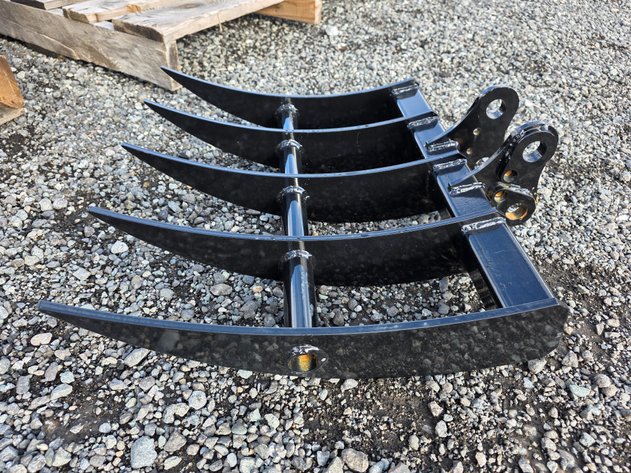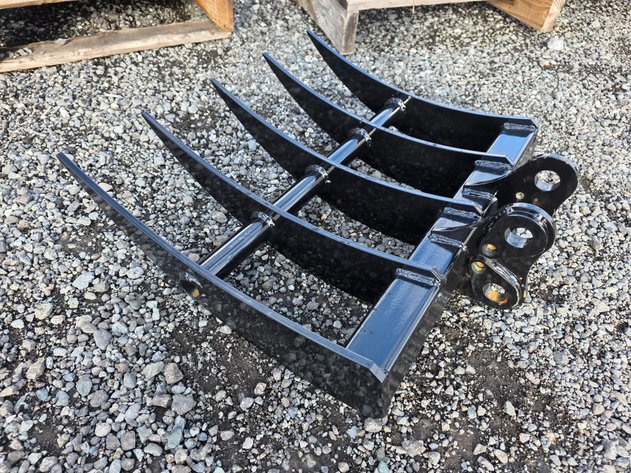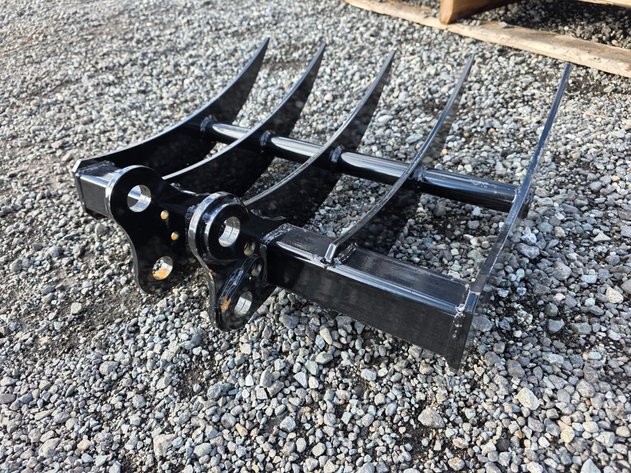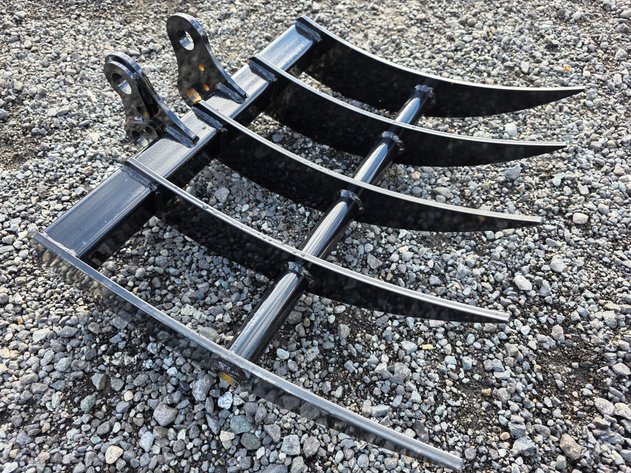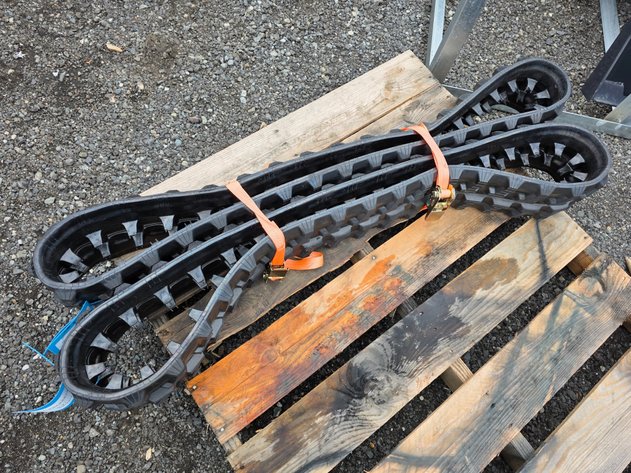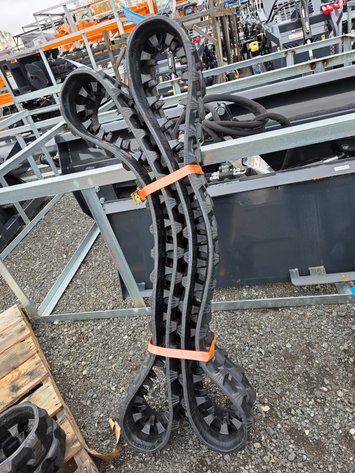Items Search
609 results found
Youert Mud Bucket Attachment - U12-60
Auction: November 2025 Equipment Auction
- Tuesday, October 28, 2025 (Start)
- Tuesday, November 4, 2025 (End)
Make: Youert Item: Mud Bucket Attachment Model: U12-60 Year: 2025 S/N: N/A Weight: N/A Dimensions: N/A Condition: New Other: For the auxiliary role of excavators. All information provided for the new equipment in this auction—including specifications and features—has been supplied directly by the manufacturers. Alaska Premier Auctions & Appraisals has made every reasonable effort to identify discrepancies and present accurate details through written descriptions and photographs; however, we do not guarantee the completeness or accuracy of this information. It is the sole responsibility of each bidder to independently verify the condition, specifications, and suitability of any item prior to placing a bid. We strongly encourage all prospective bidders to thoroughly review all available images and descriptions and to attend the scheduled in-person preview for a firsthand inspection. Note: By bidding, you agree that any loading assistance provided by Alaska Premier Auctions & Appraisals, LLC (APAA)—including use of forklifts or other equipment—is offered solely as a courtesy. APAA assumes no liability for damage or injury resulting from such assistance. We reserve the right, at our sole discretion, to decline loading assistance. Under no circumstances will APAA load self-powered equipment such as skid steers, excavators, or similar machinery. Winning bidders are encouraged to bring their own equipment for loading. If utilizing APAA for assistance, a signed liability release may be required prior to loading. All sales are final. No refunds, returns, or adjustments will be made in the event of inaccurate, incomplete, or undisclosed information.
YOUERT Mud Bucket Attachment - U12-60
Auction: November 2025 Equipment Auction
- Tuesday, October 28, 2025 (Start)
- Tuesday, November 4, 2025 (End)
Make: Youert Item: Mud Bucket Attachment Model: U12-60 Year: 2025 S/N: N/A Weight: N/A Dimensions: N/A Condition: New Other: For the auxiliary role of excavators. All information provided for the new equipment in this auction—including specifications and features—has been supplied directly by the manufacturers. Alaska Premier Auctions & Appraisals has made every reasonable effort to identify discrepancies and present accurate details through written descriptions and photographs; however, we do not guarantee the completeness or accuracy of this information. It is the sole responsibility of each bidder to independently verify the condition, specifications, and suitability of any item prior to placing a bid. We strongly encourage all prospective bidders to thoroughly review all available images and descriptions and to attend the scheduled in-person preview for a firsthand inspection. Note: By bidding, you agree that any loading assistance provided by Alaska Premier Auctions & Appraisals, LLC (APAA)—including use of forklifts or other equipment—is offered solely as a courtesy. APAA assumes no liability for damage or injury resulting from such assistance. We reserve the right, at our sole discretion, to decline loading assistance. Under no circumstances will APAA load self-powered equipment such as skid steers, excavators, or similar machinery. Winning bidders are encouraged to bring their own equipment for loading. If utilizing APAA for assistance, a signed liability release may be required prior to loading. All sales are final. No refunds, returns, or adjustments will be made in the event of inaccurate, incomplete, or undisclosed information.
YOUERT Mud Bucket Attachment - U12-60
Auction: November 2025 Equipment Auction
- Tuesday, October 28, 2025 (Start)
- Tuesday, November 4, 2025 (End)
Make: Youert Item: Mud Bucket Attachment Model: U12-60 Year: 2025 S/N: N/A Weight: N/A Dimensions: N/A Condition: New Other: For the auxiliary role of excavators. All information provided for the new equipment in this auction—including specifications and features—has been supplied directly by the manufacturers. Alaska Premier Auctions & Appraisals has made every reasonable effort to identify discrepancies and present accurate details through written descriptions and photographs; however, we do not guarantee the completeness or accuracy of this information. It is the sole responsibility of each bidder to independently verify the condition, specifications, and suitability of any item prior to placing a bid. We strongly encourage all prospective bidders to thoroughly review all available images and descriptions and to attend the scheduled in-person preview for a firsthand inspection. Note: By bidding, you agree that any loading assistance provided by Alaska Premier Auctions & Appraisals, LLC (APAA)—including use of forklifts or other equipment—is offered solely as a courtesy. APAA assumes no liability for damage or injury resulting from such assistance. We reserve the right, at our sole discretion, to decline loading assistance. Under no circumstances will APAA load self-powered equipment such as skid steers, excavators, or similar machinery. Winning bidders are encouraged to bring their own equipment for loading. If utilizing APAA for assistance, a signed liability release may be required prior to loading. All sales are final. No refunds, returns, or adjustments will be made in the event of inaccurate, incomplete, or undisclosed information.
YOUERT Rake Attachment - U12-50
Auction: November 2025 Equipment Auction
- Tuesday, October 28, 2025 (Start)
- Tuesday, November 4, 2025 (End)
Make: Youert Item: Rake Attachment Model: U12-50 Year: 2025 S/N: N/A Weight: N/A Dimensions: N/A Condition: New Other: For the auxiliary role of excavators. All information provided for the new equipment in this auction—including specifications and features—has been supplied directly by the manufacturers. Alaska Premier Auctions & Appraisals has made every reasonable effort to identify discrepancies and present accurate details through written descriptions and photographs; however, we do not guarantee the completeness or accuracy of this information. It is the sole responsibility of each bidder to independently verify the condition, specifications, and suitability of any item prior to placing a bid. We strongly encourage all prospective bidders to thoroughly review all available images and descriptions and to attend the scheduled in-person preview for a firsthand inspection. Note: By bidding, you agree that any loading assistance provided by Alaska Premier Auctions & Appraisals, LLC (APAA)—including use of forklifts or other equipment—is offered solely as a courtesy. APAA assumes no liability for damage or injury resulting from such assistance. We reserve the right, at our sole discretion, to decline loading assistance. Under no circumstances will APAA load self-powered equipment such as skid steers, excavators, or similar machinery. Winning bidders are encouraged to bring their own equipment for loading. If utilizing APAA for assistance, a signed liability release may be required prior to loading. All sales are final. No refunds, returns, or adjustments will be made in the event of inaccurate, incomplete, or undisclosed information.
YOUERT Rake Attachment - U12-50
Auction: November 2025 Equipment Auction
- Tuesday, October 28, 2025 (Start)
- Tuesday, November 4, 2025 (End)
Make: Youert Item: Rake Attachment Model: U12-50 Year: 2025 S/N: N/A Weight: N/A Dimensions: N/A Condition: New Other: For the auxiliary role of excavators. All information provided for the new equipment in this auction—including specifications and features—has been supplied directly by the manufacturers. Alaska Premier Auctions & Appraisals has made every reasonable effort to identify discrepancies and present accurate details through written descriptions and photographs; however, we do not guarantee the completeness or accuracy of this information. It is the sole responsibility of each bidder to independently verify the condition, specifications, and suitability of any item prior to placing a bid. We strongly encourage all prospective bidders to thoroughly review all available images and descriptions and to attend the scheduled in-person preview for a firsthand inspection. Note: By bidding, you agree that any loading assistance provided by Alaska Premier Auctions & Appraisals, LLC (APAA)—including use of forklifts or other equipment—is offered solely as a courtesy. APAA assumes no liability for damage or injury resulting from such assistance. We reserve the right, at our sole discretion, to decline loading assistance. Under no circumstances will APAA load self-powered equipment such as skid steers, excavators, or similar machinery. Winning bidders are encouraged to bring their own equipment for loading. If utilizing APAA for assistance, a signed liability release may be required prior to loading. All sales are final. No refunds, returns, or adjustments will be made in the event of inaccurate, incomplete, or undisclosed information.
YOUERT Rake Attachment - U12-50
Auction: November 2025 Equipment Auction
- Tuesday, October 28, 2025 (Start)
- Tuesday, November 4, 2025 (End)
Make: Youert Item: Rake Attachment Model: U12-50 Year: 2025 S/N: N/A Weight: N/A Dimensions: N/A Condition: New Other: For the auxiliary role of excavators. All information provided for the new equipment in this auction—including specifications and features—has been supplied directly by the manufacturers. Alaska Premier Auctions & Appraisals has made every reasonable effort to identify discrepancies and present accurate details through written descriptions and photographs; however, we do not guarantee the completeness or accuracy of this information. It is the sole responsibility of each bidder to independently verify the condition, specifications, and suitability of any item prior to placing a bid. We strongly encourage all prospective bidders to thoroughly review all available images and descriptions and to attend the scheduled in-person preview for a firsthand inspection. Note: By bidding, you agree that any loading assistance provided by Alaska Premier Auctions & Appraisals, LLC (APAA)—including use of forklifts or other equipment—is offered solely as a courtesy. APAA assumes no liability for damage or injury resulting from such assistance. We reserve the right, at our sole discretion, to decline loading assistance. Under no circumstances will APAA load self-powered equipment such as skid steers, excavators, or similar machinery. Winning bidders are encouraged to bring their own equipment for loading. If utilizing APAA for assistance, a signed liability release may be required prior to loading. All sales are final. No refunds, returns, or adjustments will be made in the event of inaccurate, incomplete, or undisclosed information.
YOUERT Rake Attachment - U12-50
Auction: November 2025 Equipment Auction
- Tuesday, October 28, 2025 (Start)
- Tuesday, November 4, 2025 (End)
Make: Youert Item: Rake Attachment Model: U12-50 Year: 2025 S/N: N/A Weight: N/A Dimensions: N/A Condition: New Other: For the auxiliary role of excavators. All information provided for the new equipment in this auction—including specifications and features—has been supplied directly by the manufacturers. Alaska Premier Auctions & Appraisals has made every reasonable effort to identify discrepancies and present accurate details through written descriptions and photographs; however, we do not guarantee the completeness or accuracy of this information. It is the sole responsibility of each bidder to independently verify the condition, specifications, and suitability of any item prior to placing a bid. We strongly encourage all prospective bidders to thoroughly review all available images and descriptions and to attend the scheduled in-person preview for a firsthand inspection. Note: By bidding, you agree that any loading assistance provided by Alaska Premier Auctions & Appraisals, LLC (APAA)—including use of forklifts or other equipment—is offered solely as a courtesy. APAA assumes no liability for damage or injury resulting from such assistance. We reserve the right, at our sole discretion, to decline loading assistance. Under no circumstances will APAA load self-powered equipment such as skid steers, excavators, or similar machinery. Winning bidders are encouraged to bring their own equipment for loading. If utilizing APAA for assistance, a signed liability release may be required prior to loading. All sales are final. No refunds, returns, or adjustments will be made in the event of inaccurate, incomplete, or undisclosed information.
YOUERT Rubber Track Attachments (1 Pair)
Auction: November 2025 Equipment Auction
- Tuesday, October 28, 2025 (Start)
- Tuesday, November 4, 2025 (End)
Make: Youert Item: Rubber Track Attachments Model: N/A Year: 2025 S/N: N/A Weight: N/A Dimensions: 180 x 72 x 37 Condition: New Other: One set for a total of two tracks. All information provided for the new equipment in this auction—including specifications and features—has been supplied directly by the manufacturers. Alaska Premier Auctions & Appraisals has made every reasonable effort to identify discrepancies and present accurate details through written descriptions and photographs; however, we do not guarantee the completeness or accuracy of this information. It is the sole responsibility of each bidder to independently verify the condition, specifications, and suitability of any item prior to placing a bid. We strongly encourage all prospective bidders to thoroughly review all available images and descriptions and to attend the scheduled in-person preview for a firsthand inspection. Note: By bidding, you agree that any loading assistance provided by Alaska Premier Auctions & Appraisals, LLC (APAA)—including use of forklifts or other equipment—is offered solely as a courtesy. APAA assumes no liability for damage or injury resulting from such assistance. We reserve the right, at our sole discretion, to decline loading assistance. Under no circumstances will APAA load self-powered equipment such as skid steers, excavators, or similar machinery. Winning bidders are encouraged to bring their own equipment for loading. If utilizing APAA for assistance, a signed liability release may be required prior to loading. All sales are final. No refunds, returns, or adjustments will be made in the event of inaccurate, incomplete, or undisclosed information.
YOUERT Rubber Track Attachments (1 Pair)
Auction: November 2025 Equipment Auction
- Tuesday, October 28, 2025 (Start)
- Tuesday, November 4, 2025 (End)
Make: Youert Item: Rubber Track Attachments Model: N/A Year: 2025 S/N: N/A Weight: N/A Dimensions: 180 x 72 x 37 Condition: New Other: One set for a total of two tracks. All information provided for the new equipment in this auction—including specifications and features—has been supplied directly by the manufacturers. Alaska Premier Auctions & Appraisals has made every reasonable effort to identify discrepancies and present accurate details through written descriptions and photographs; however, we do not guarantee the completeness or accuracy of this information. It is the sole responsibility of each bidder to independently verify the condition, specifications, and suitability of any item prior to placing a bid. We strongly encourage all prospective bidders to thoroughly review all available images and descriptions and to attend the scheduled in-person preview for a firsthand inspection. Note: By bidding, you agree that any loading assistance provided by Alaska Premier Auctions & Appraisals, LLC (APAA)—including use of forklifts or other equipment—is offered solely as a courtesy. APAA assumes no liability for damage or injury resulting from such assistance. We reserve the right, at our sole discretion, to decline loading assistance. Under no circumstances will APAA load self-powered equipment such as skid steers, excavators, or similar machinery. Winning bidders are encouraged to bring their own equipment for loading. If utilizing APAA for assistance, a signed liability release may be required prior to loading. All sales are final. No refunds, returns, or adjustments will be made in the event of inaccurate, incomplete, or undisclosed information.
YOUERT Rubber Track Attachments (1 Pair)
Auction: November 2025 Equipment Auction
- Tuesday, October 28, 2025 (Start)
- Tuesday, November 4, 2025 (End)
Make: Youert Item: Rubber Track Attachments Model: N/A Year: 2025 S/N: N/A Weight: N/A Dimensions: 180 x 72 x 37 Condition: New Other: One set for a total of two tracks. All information provided for the new equipment in this auction—including specifications and features—has been supplied directly by the manufacturers. Alaska Premier Auctions & Appraisals has made every reasonable effort to identify discrepancies and present accurate details through written descriptions and photographs; however, we do not guarantee the completeness or accuracy of this information. It is the sole responsibility of each bidder to independently verify the condition, specifications, and suitability of any item prior to placing a bid. We strongly encourage all prospective bidders to thoroughly review all available images and descriptions and to attend the scheduled in-person preview for a firsthand inspection. Note: By bidding, you agree that any loading assistance provided by Alaska Premier Auctions & Appraisals, LLC (APAA)—including use of forklifts or other equipment—is offered solely as a courtesy. APAA assumes no liability for damage or injury resulting from such assistance. We reserve the right, at our sole discretion, to decline loading assistance. Under no circumstances will APAA load self-powered equipment such as skid steers, excavators, or similar machinery. Winning bidders are encouraged to bring their own equipment for loading. If utilizing APAA for assistance, a signed liability release may be required prior to loading. All sales are final. No refunds, returns, or adjustments will be made in the event of inaccurate, incomplete, or undisclosed information.
YOUERT Rubber Track Attachments (1 Pair)
Auction: November 2025 Equipment Auction
- Tuesday, October 28, 2025 (Start)
- Tuesday, November 4, 2025 (End)
Make: Youert Item: Rubber Track Attachments Model: N/A Year: 2025 S/N: N/A Weight: N/A Dimensions: 180 x 72 x 37 Condition: New Other: One set for a total of two tracks. All information provided for the new equipment in this auction—including specifications and features—has been supplied directly by the manufacturers. Alaska Premier Auctions & Appraisals has made every reasonable effort to identify discrepancies and present accurate details through written descriptions and photographs; however, we do not guarantee the completeness or accuracy of this information. It is the sole responsibility of each bidder to independently verify the condition, specifications, and suitability of any item prior to placing a bid. We strongly encourage all prospective bidders to thoroughly review all available images and descriptions and to attend the scheduled in-person preview for a firsthand inspection. Note: By bidding, you agree that any loading assistance provided by Alaska Premier Auctions & Appraisals, LLC (APAA)—including use of forklifts or other equipment—is offered solely as a courtesy. APAA assumes no liability for damage or injury resulting from such assistance. We reserve the right, at our sole discretion, to decline loading assistance. Under no circumstances will APAA load self-powered equipment such as skid steers, excavators, or similar machinery. Winning bidders are encouraged to bring their own equipment for loading. If utilizing APAA for assistance, a signed liability release may be required prior to loading. All sales are final. No refunds, returns, or adjustments will be made in the event of inaccurate, incomplete, or undisclosed information.
YOUERT Rubber Track Attachments (1 Pair)
Auction: November 2025 Equipment Auction
- Tuesday, October 28, 2025 (Start)
- Tuesday, November 4, 2025 (End)
Make: Youert Item: Rubber Track Attachments Model: N/A Year: 2025 S/N: N/A Weight: N/A Dimensions: 180 x 72 x 37 Condition: New Other: One set for a total of two tracks. All information provided for the new equipment in this auction—including specifications and features—has been supplied directly by the manufacturers. Alaska Premier Auctions & Appraisals has made every reasonable effort to identify discrepancies and present accurate details through written descriptions and photographs; however, we do not guarantee the completeness or accuracy of this information. It is the sole responsibility of each bidder to independently verify the condition, specifications, and suitability of any item prior to placing a bid. We strongly encourage all prospective bidders to thoroughly review all available images and descriptions and to attend the scheduled in-person preview for a firsthand inspection. Note: By bidding, you agree that any loading assistance provided by Alaska Premier Auctions & Appraisals, LLC (APAA)—including use of forklifts or other equipment—is offered solely as a courtesy. APAA assumes no liability for damage or injury resulting from such assistance. We reserve the right, at our sole discretion, to decline loading assistance. Under no circumstances will APAA load self-powered equipment such as skid steers, excavators, or similar machinery. Winning bidders are encouraged to bring their own equipment for loading. If utilizing APAA for assistance, a signed liability release may be required prior to loading. All sales are final. No refunds, returns, or adjustments will be made in the event of inaccurate, incomplete, or undisclosed information.
YOUERT Rubber Track Attachments (1 Pair)
Auction: November 2025 Equipment Auction
- Tuesday, October 28, 2025 (Start)
- Tuesday, November 4, 2025 (End)
Make: Youert Item: Rubber Track Attachments Model: N/A Year: 2025 S/N: N/A Weight: N/A Dimensions: 180 x 72 x 37 Condition: New Other: One set for a total of two tracks. All information provided for the new equipment in this auction—including specifications and features—has been supplied directly by the manufacturers. Alaska Premier Auctions & Appraisals has made every reasonable effort to identify discrepancies and present accurate details through written descriptions and photographs; however, we do not guarantee the completeness or accuracy of this information. It is the sole responsibility of each bidder to independently verify the condition, specifications, and suitability of any item prior to placing a bid. We strongly encourage all prospective bidders to thoroughly review all available images and descriptions and to attend the scheduled in-person preview for a firsthand inspection. Note: By bidding, you agree that any loading assistance provided by Alaska Premier Auctions & Appraisals, LLC (APAA)—including use of forklifts or other equipment—is offered solely as a courtesy. APAA assumes no liability for damage or injury resulting from such assistance. We reserve the right, at our sole discretion, to decline loading assistance. Under no circumstances will APAA load self-powered equipment such as skid steers, excavators, or similar machinery. Winning bidders are encouraged to bring their own equipment for loading. If utilizing APAA for assistance, a signed liability release may be required prior to loading. All sales are final. No refunds, returns, or adjustments will be made in the event of inaccurate, incomplete, or undisclosed information.
YOUERT Rubber Track Attachments (1 Pair)
Auction: November 2025 Equipment Auction
- Tuesday, October 28, 2025 (Start)
- Tuesday, November 4, 2025 (End)
Make: Youert Item: Rubber Track Attachments Model: N/A Year: 2025 S/N: N/A Weight: N/A Dimensions: 180 x 72 x 37 Condition: New Other: One set for a total of two tracks. All information provided for the new equipment in this auction—including specifications and features—has been supplied directly by the manufacturers. Alaska Premier Auctions & Appraisals has made every reasonable effort to identify discrepancies and present accurate details through written descriptions and photographs; however, we do not guarantee the completeness or accuracy of this information. It is the sole responsibility of each bidder to independently verify the condition, specifications, and suitability of any item prior to placing a bid. We strongly encourage all prospective bidders to thoroughly review all available images and descriptions and to attend the scheduled in-person preview for a firsthand inspection. Note: By bidding, you agree that any loading assistance provided by Alaska Premier Auctions & Appraisals, LLC (APAA)—including use of forklifts or other equipment—is offered solely as a courtesy. APAA assumes no liability for damage or injury resulting from such assistance. We reserve the right, at our sole discretion, to decline loading assistance. Under no circumstances will APAA load self-powered equipment such as skid steers, excavators, or similar machinery. Winning bidders are encouraged to bring their own equipment for loading. If utilizing APAA for assistance, a signed liability release may be required prior to loading. All sales are final. No refunds, returns, or adjustments will be made in the event of inaccurate, incomplete, or undisclosed information.
YOUERT Rubber Track Attachments (1 Pair)
Auction: November 2025 Equipment Auction
- Tuesday, October 28, 2025 (Start)
- Tuesday, November 4, 2025 (End)
Make: Youert Item: Rubber Track Attachments Model: N/A Year: 2025 S/N: N/A Weight: N/A Dimensions: 180 x 72 x 37 Condition: New Other: One set for a total of two tracks. All information provided for the new equipment in this auction—including specifications and features—has been supplied directly by the manufacturers. Alaska Premier Auctions & Appraisals has made every reasonable effort to identify discrepancies and present accurate details through written descriptions and photographs; however, we do not guarantee the completeness or accuracy of this information. It is the sole responsibility of each bidder to independently verify the condition, specifications, and suitability of any item prior to placing a bid. We strongly encourage all prospective bidders to thoroughly review all available images and descriptions and to attend the scheduled in-person preview for a firsthand inspection. Note: By bidding, you agree that any loading assistance provided by Alaska Premier Auctions & Appraisals, LLC (APAA)—including use of forklifts or other equipment—is offered solely as a courtesy. APAA assumes no liability for damage or injury resulting from such assistance. We reserve the right, at our sole discretion, to decline loading assistance. Under no circumstances will APAA load self-powered equipment such as skid steers, excavators, or similar machinery. Winning bidders are encouraged to bring their own equipment for loading. If utilizing APAA for assistance, a signed liability release may be required prior to loading. All sales are final. No refunds, returns, or adjustments will be made in the event of inaccurate, incomplete, or undisclosed information.
YOUERT Rubber Track Attachments (1 Pair)
Auction: November 2025 Equipment Auction
- Tuesday, October 28, 2025 (Start)
- Tuesday, November 4, 2025 (End)
Make: Youert Item: Rubber Track Attachments Model: N/A Year: 2025 S/N: N/A Weight: N/A Dimensions: 180 x 72 x 37 Condition: New Other: One set for a total of two tracks. All information provided for the new equipment in this auction—including specifications and features—has been supplied directly by the manufacturers. Alaska Premier Auctions & Appraisals has made every reasonable effort to identify discrepancies and present accurate details through written descriptions and photographs; however, we do not guarantee the completeness or accuracy of this information. It is the sole responsibility of each bidder to independently verify the condition, specifications, and suitability of any item prior to placing a bid. We strongly encourage all prospective bidders to thoroughly review all available images and descriptions and to attend the scheduled in-person preview for a firsthand inspection. Note: By bidding, you agree that any loading assistance provided by Alaska Premier Auctions & Appraisals, LLC (APAA)—including use of forklifts or other equipment—is offered solely as a courtesy. APAA assumes no liability for damage or injury resulting from such assistance. We reserve the right, at our sole discretion, to decline loading assistance. Under no circumstances will APAA load self-powered equipment such as skid steers, excavators, or similar machinery. Winning bidders are encouraged to bring their own equipment for loading. If utilizing APAA for assistance, a signed liability release may be required prior to loading. All sales are final. No refunds, returns, or adjustments will be made in the event of inaccurate, incomplete, or undisclosed information.
YOUERT Rubber Track Attachments (1 Pair)
Auction: November 2025 Equipment Auction
- Tuesday, October 28, 2025 (Start)
- Tuesday, November 4, 2025 (End)
Make: Youert Item: Rubber Track Attachments Model: N/A Year: 2025 S/N: N/A Weight: N/A Dimensions: 180 x 72 x 37 Condition: New Other: One set for a total of two tracks. All information provided for the new equipment in this auction—including specifications and features—has been supplied directly by the manufacturers. Alaska Premier Auctions & Appraisals has made every reasonable effort to identify discrepancies and present accurate details through written descriptions and photographs; however, we do not guarantee the completeness or accuracy of this information. It is the sole responsibility of each bidder to independently verify the condition, specifications, and suitability of any item prior to placing a bid. We strongly encourage all prospective bidders to thoroughly review all available images and descriptions and to attend the scheduled in-person preview for a firsthand inspection. Note: By bidding, you agree that any loading assistance provided by Alaska Premier Auctions & Appraisals, LLC (APAA)—including use of forklifts or other equipment—is offered solely as a courtesy. APAA assumes no liability for damage or injury resulting from such assistance. We reserve the right, at our sole discretion, to decline loading assistance. Under no circumstances will APAA load self-powered equipment such as skid steers, excavators, or similar machinery. Winning bidders are encouraged to bring their own equipment for loading. If utilizing APAA for assistance, a signed liability release may be required prior to loading. All sales are final. No refunds, returns, or adjustments will be made in the event of inaccurate, incomplete, or undisclosed information.
YOUERT Rubber Track Attachments (1 Pair)
Auction: November 2025 Equipment Auction
- Tuesday, October 28, 2025 (Start)
- Tuesday, November 4, 2025 (End)
Make: Youert Item: Rubber Track Attachments Model: N/A Year: 2025 S/N: N/A Weight: N/A Dimensions: 180 x 72 x 37 Condition: New Other: One set for a total of two tracks. All information provided for the new equipment in this auction—including specifications and features—has been supplied directly by the manufacturers. Alaska Premier Auctions & Appraisals has made every reasonable effort to identify discrepancies and present accurate details through written descriptions and photographs; however, we do not guarantee the completeness or accuracy of this information. It is the sole responsibility of each bidder to independently verify the condition, specifications, and suitability of any item prior to placing a bid. We strongly encourage all prospective bidders to thoroughly review all available images and descriptions and to attend the scheduled in-person preview for a firsthand inspection. Note: By bidding, you agree that any loading assistance provided by Alaska Premier Auctions & Appraisals, LLC (APAA)—including use of forklifts or other equipment—is offered solely as a courtesy. APAA assumes no liability for damage or injury resulting from such assistance. We reserve the right, at our sole discretion, to decline loading assistance. Under no circumstances will APAA load self-powered equipment such as skid steers, excavators, or similar machinery. Winning bidders are encouraged to bring their own equipment for loading. If utilizing APAA for assistance, a signed liability release may be required prior to loading. All sales are final. No refunds, returns, or adjustments will be made in the event of inaccurate, incomplete, or undisclosed information.
YOUERT Rubber Track Attachments (1 Pair)
Auction: November 2025 Equipment Auction
- Tuesday, October 28, 2025 (Start)
- Tuesday, November 4, 2025 (End)
Make: Youert Item: Rubber Track Attachments Model: N/A Year: 2025 S/N: N/A Weight: N/A Dimensions: 180 x 72 x 37 Condition: New Other: One set for a total of two tracks. All information provided for the new equipment in this auction—including specifications and features—has been supplied directly by the manufacturers. Alaska Premier Auctions & Appraisals has made every reasonable effort to identify discrepancies and present accurate details through written descriptions and photographs; however, we do not guarantee the completeness or accuracy of this information. It is the sole responsibility of each bidder to independently verify the condition, specifications, and suitability of any item prior to placing a bid. We strongly encourage all prospective bidders to thoroughly review all available images and descriptions and to attend the scheduled in-person preview for a firsthand inspection. Note: By bidding, you agree that any loading assistance provided by Alaska Premier Auctions & Appraisals, LLC (APAA)—including use of forklifts or other equipment—is offered solely as a courtesy. APAA assumes no liability for damage or injury resulting from such assistance. We reserve the right, at our sole discretion, to decline loading assistance. Under no circumstances will APAA load self-powered equipment such as skid steers, excavators, or similar machinery. Winning bidders are encouraged to bring their own equipment for loading. If utilizing APAA for assistance, a signed liability release may be required prior to loading. All sales are final. No refunds, returns, or adjustments will be made in the event of inaccurate, incomplete, or undisclosed information.
YOUERT Rubber Track Attachments (1 Pair)
Auction: November 2025 Equipment Auction
- Tuesday, October 28, 2025 (Start)
- Tuesday, November 4, 2025 (End)
Make: Youert Item: Rubber Track Attachments Model: N/A Year: 2025 S/N: N/A Weight: N/A Dimensions: 180 x 72 x 37 Condition: New Other: One set for a total of two tracks. All information provided for the new equipment in this auction—including specifications and features—has been supplied directly by the manufacturers. Alaska Premier Auctions & Appraisals has made every reasonable effort to identify discrepancies and present accurate details through written descriptions and photographs; however, we do not guarantee the completeness or accuracy of this information. It is the sole responsibility of each bidder to independently verify the condition, specifications, and suitability of any item prior to placing a bid. We strongly encourage all prospective bidders to thoroughly review all available images and descriptions and to attend the scheduled in-person preview for a firsthand inspection. Note: By bidding, you agree that any loading assistance provided by Alaska Premier Auctions & Appraisals, LLC (APAA)—including use of forklifts or other equipment—is offered solely as a courtesy. APAA assumes no liability for damage or injury resulting from such assistance. We reserve the right, at our sole discretion, to decline loading assistance. Under no circumstances will APAA load self-powered equipment such as skid steers, excavators, or similar machinery. Winning bidders are encouraged to bring their own equipment for loading. If utilizing APAA for assistance, a signed liability release may be required prior to loading. All sales are final. No refunds, returns, or adjustments will be made in the event of inaccurate, incomplete, or undisclosed information.




